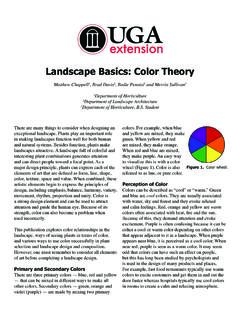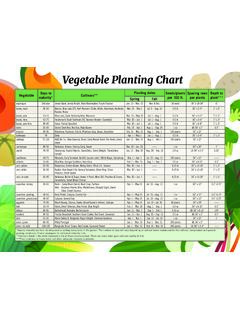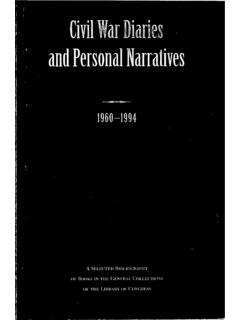Transcription of Time Management 10 Strategies for Better Time Management
1 Time Management10 Strategies for Better Time ManagementTime ManagementTime Management10 Strategies for Better Time Management10 Strategies for Better Time ManagementUpdated by: Roxie Price University of Georgia ExtensionDana Carney University of Georgia ExtensionRachael Clews K-State Research and ExtensionOriginally written by:Sue W. ChapmanMichael Rupured2 UGA Cooperative Extension Circular 1042 | Time How You Spend Your TimeA time log is a helpful way to determine how you use your time. Record what you are doing in 15-minute intervals for a week or two. Evaluate the results: Did everything you needed to do get done?
2 Which tasks require the most time? What time of day when you are mostproductive? Where is most of your time is devoted( job, family, personal, recreation)?Identifying your most time-consuming tasks and determining whether you are investing your time in the most important activities can help you to determine a course of action. Having a good sense of the time required for routine tasks can help you be more realistic in planning and estimating how much time is available for other activities. Many apps exist to help you keep track of your time, as mentioned in Strategy 3.
3 10 People who practice good time Management techniques often find that they: Are more productive. Have more energy for things they need to accomplish. Feel less stressed. Have more free time to do the things they want. Get more things done. Relate more positively to others. Feel Better about themselves. (Dodd and Subdheim, 2005)Finding a time Management strategy that works best for you depends on your personality, ability to self-motivate, and level of self-discipline. By incorporating some, or all the ten Strategies below, you can more effectively manage your for Better Time ManagementStrategies for Better Time ManagementYou cannot manage time; you manage the events in your life in relation to term Time Management is a misnomer.
4 You may often wish for more time, but you only get 24 hours, 1,440 minutes, or 86,400 seconds each day. How you use that time depends on skills learned through self-analysis, planning, evaluation, and self-control. MUCH LIKE MONEY, TIME IS BOTH VALUABLE AND LIMITED: it must be protected, used wisely, and Use a Planning ToolTime Management experts recommend using a personal planning tool to improve your productivity. Personal planning tools include planners, calendars, phone apps, wall charts, index cards, pocket diaries , and notebooks. Writing down your tasks, schedules, and items to remember can free your mind to focus on your priorities.
5 Auditory learners may prefer to dictate their thoughts instead. The key is to find one planning tool that works for you and use that tool consistently. 3 UGA Cooperative Extension Circular 1042 | Time Management2. Set PrioritiesManaging your time effectively requires a distinction between what is important and what is urgent (MacKenzie, 1990). Experts agree that the most important tasks usually aren t the most urgent tasks. However, we tend to let the urgent tasks dominate our lives. Covey, Merrill, and Merrill (1994) categorize activities into four quadrants in their Time Management Matrix: urgent, not urgent, important, and not important.
6 While activities that are both urgent and important must be done, Covey et al. suggests spending less time on activities that are not important (regardless of their urgency) to gain time for activities that are not urgent but important. Focusing on these important activities allows you to gain greater control over your time and may reduce the number of important tasks that become urgent. Example Time Management MatrixUrgentNot UrgentImportantDo these tasks as soon as : Submit job application by 5 Pick up sick child from school Call plumber to fix leaking toiletDefer these tasks until all urgent and important tasks have been : Schedule dentist appointment Reply to coworker s email regarding future event Plan family reunionNot ImportantDelegate these tasks to the appropriate people who can manage : Help son with homework Pull weeds from flower beds Make dinner for familyDelete these tasks they are often time.
7 Respond to social media comments Online shopping Finish watching TV showCreating a to do list is an easy way to prioritize. Whether you need a daily, weekly, or monthly list depends on your lifestyle. Be careful to keep list-making from getting out of control. List manageable tasks rather than goals or multi-step plans. Rank the items on your to do list in order of priority (both important and urgent). You may choose to group items in categories such as high priority, medium priority, or low priority; number them in order of priority; or use a color-coding system.
8 The goal is not to mark off the most items, but to mark off the highest priority items (MacKenzie, 1990). A prioritized to do list allows you to set boundaries so you can say no to activities that may be interesting or provide a sense of achievement but do not fit your basic Cooperative Extension Circular 1042 | Time ManagementWhen using a planning tool: Always record your information on the tool itself. Jotting notes elsewhere that must be transferred later is inefficient and wastes more time. Review your planning tool daily. Keep a list of your priorities in your planning tool and refer to it often.
9 Keep planning tools synchronized. If you keep more than one, make sure your phone, computer, and paper planning tools match. Keep a back-up on your phone can be great planning tools. Apps typically fall into one of the following categories: Time Trackers Gain an awareness of how you spend your time. Time Savers Increase productivity and break time-wasting habits. Task Managers Prioritize and organize tasks to improve time Management . Habit Developers Create healthy habits to encourage time Get OrganizedDisorganization leads to poor time Management . Research has shown that clutter has a strong negative impact on perceived well-being (Roster, 2016).
10 To improve our time Management , get organized. Set up three boxes (or corners of a room) labeled Keep, Give Away, and Toss. Sort items into these boxes. Discard items in your Toss box. Your Give Away box may include items you want to sell, donate, or discard. The next step is to improve the time you spend processing information. For example, tasks such as email can eat up your day. To combat wasted time, implement an email organization system that allows you to process the information in each email as efficiently as possible. Use folders, flagging, or a color-coded system to keep track of what s what.









